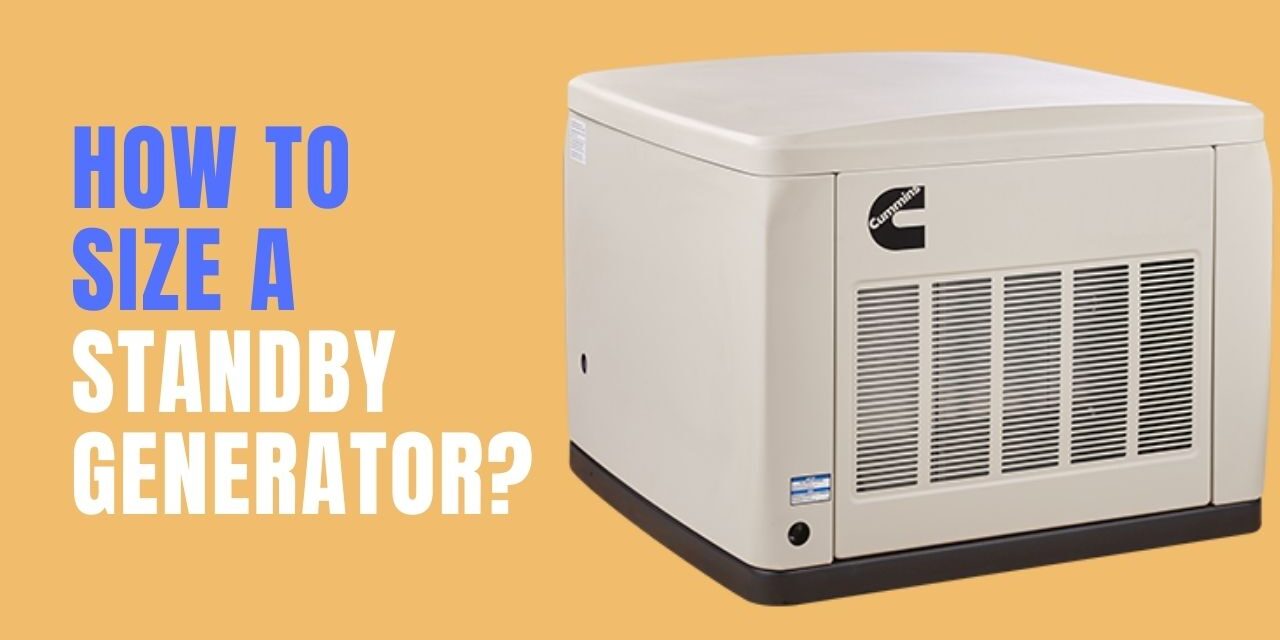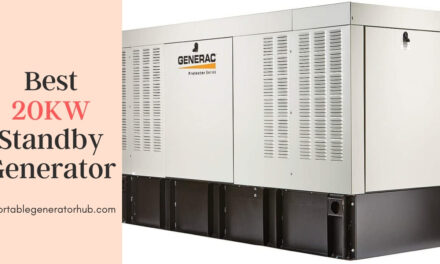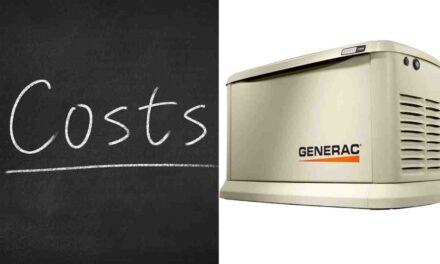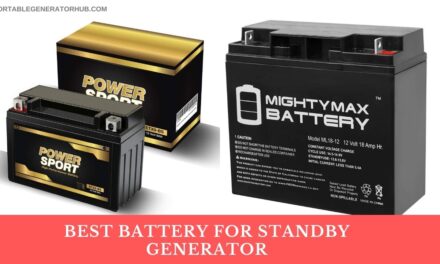
In this article, we want to address one of the most frequently asked questions about generators – how do I size a generator for my house? We keep getting the question time and time again, so we decided to address it with a detailed article.
When people talk about the size of a generator in this context, they’re not talking about the physical size. What they mean is the power-generating capacity of the generator.
Different generators have different generating capacities, which are usually measured in watts and kilowatts. When you see a 10KW generator, know that it generates 10KW or 10,000 watts of power.
So, you’re the one that will determine the right size of generator for your home. Just follow the steps discussed below.
What Size Generator Do I Need for My House Appliance Chart?
Here are the steps to follow.
Step 1 – List out in a chart all the electrical appliances that you want to power with the generator.
Step 2 – Check the power consumption of each of them. It is usually stated on their label. Since generators are rated in watts, the power consumption must be in watts.
However, the power consumption of some devices is stated in amps. You can convert the amps to watts. All you have to do is to multiply the amps by its voltage, usually 120V.
Watts = Amps X Voltage.
Step 3 – Add up all the figures to get the total.
Step 4 – Add extra 500 – 1,000 watts to the total figure and work on the final figure. The extra wattage is for two purposes. First, it will give room for additional electrical equipment that you may want to buy in the future.
Second, you’ll shorten the lifespan of your generator if you use the generator whose capacity is exactly your total consumption.
It means the generator will be working at 100% load capacity. The load will put a strain on its engine, so it will be noisy and its lifespan will be shortened.
Usually, two types of wattage are stated – starting wattage and running wattage. The running wattage is also known as the rated wattage. Here’s the difference.
The starting wattage is needed to start up the device, while it runs on the rated wattage. The starting wattage is usually higher than the rated wattage.
Not every piece of equipment will have its power consumption stated on it. You may have to search the internet for the figure. To make this easy for you, we have given you the starting and rated wattages of common appliances below.
| S/N | Appliance | Starting Wattage | Running Wattage |
| 1 | Laptop | 250 | 250 |
| 2 | LCD TV (55”) | 230 | 230 |
| 3 | Dishwasher | 1450 | 1400 |
| 4 | Air Compressor | 4000 | 2000 |
| 5 | Air Conditioner (10,000 BTU) | 2200 | 1500 |
| 6 | Disc Grinder | 4000 | 2000 |
| 7 | Printer | 500 | 500 |
| 8 | Table Saw | 4500 | 1800 |
| 9 | Router | 1500 | 600 |
| 10 | Water Heater | 4500 | 4500 |
| 11 | Electric Chainsaw | 2400 | 1200 |
Going through the table above, you may observe that the starting and running wattages of some devices are the same. Yes, you’re right. It’s because they don’t have a motor.
On the other hand, devices whose starting wattages are higher than their rated wattages work with a motor. These motors need huge power to start up.
What Size Generator Do I Need to Run a 2000 Square Foot House?
People often ask for the size of a generator to run their houses, but what they really need is the capacity of the generator. In the same way they talk about the size of their houses, when what really matters is their total power consumption.
This is because a smaller house may have more powerful electrical appliances than some bigger houses, and may require a higher-capacity generator than the bigger houses. We understand the reason why you should get the right generator for your house.
If you get a smaller generator, it may not be able to power all your equipment, and the purpose of getting a generator will be defeated. On the other hand, if the generator is much bigger than what you need, you’ll be wasting money and energy.
In our estimate, with a 7,500 to 8,000-watt generator, you should be able to power a 2000 square foot house easily. At the same time, we advise you to determine your total power consumption before purchasing a generator. It will guide you more accurately.
How Big of a Generator Do I Need for A 3000 Square Foot House?
This house is slightly bigger than the one above, so you’ll need a slightly bigger generator. By our estimate, an 8,500 to 10,000-watt generator is perfect for 3,000 Square Foot. However, we still insist that you need to list out all the items you want to power in your home.
Will a 30kW Generator Run My House?
Yes, a 30KW generator is enough to run your house and many other houses. In fact, it is big enough to run farms and big offices. As a matter of fact, a 30KW generator is likely to be too big for your house. Buying such a generator is a waste of money. And running that type of generator will be a continuous waste of money.
However, if you have your business besides your house, this generator may be a good idea. That way, you’ll power both your home and business with the same generator at the same time.
How Big of a Generator Do I Need for a 1500 Square Foot House?
If you want to power a 1500 square foot house, you can go for 2,200 to 4,000-watt generator. What makes the difference is an air conditioning unit. If you plan to run an air conditioner, a 2,200-watt generator is okay. But if you intend to use an air conditioner, then a 2,200-watt generator might not be a good idea. Since you plan to use a generator, you should go for a 4,000-watt generator.
Finally, you need to bear in mind that these answers are mere estimates. To get more accurate answers, you should list all the appliances in your house. Takedown the power consumption of each of them and total the figure. This will give you a more accurate idea of the capacity of the generator that will run your house more efficiently.
Single Unit Vs Parallel Units
Now that you know the right generator capacity for your home, you’ll have to decide whether you want a single generating set or join multiple smaller ones.
For instance, if your total power consumption is 11KW, you can purchase a single 12KW generator or connect two 6KW generators together. You could also link three 4KW generators together. The connected generators are known as parallel units.
Take note that not every portable generator can be linked together in a parallel connection. While a single unit has its advantages, parallel connections have several benefits over a single unit. Here are some of them.
Benefits of Parallel Units:
1. They Consume Less Space
Several portable generators are usually not as big and heavy as a single heavy-duty unit. So, they’ll consume less space. Also, delivering a heavy-duty, single-unit generator may require a forklift or other heavy machinery.
2. They Offer Lower Cost of Installation
Since it requires the rental of special equipment, the delivery and installation of a large single-unit generator will cost more than the delivery and installation of smaller parallel generators.
3. There’s Usage Flexibility
If you’re using a single unit, if it stops working, you can’t do anything. On the other hand, if one of the connected parallel generators goes down, you can still move on with the other one(s). You may need to shed some of the load on the system, though.
4. Longer Lifespan
In a parallel setting, there’s load sharing. This reduces the load borne by each of the generators, thereby extending their lifespan.
5. On-The-Go Power Supply
If you’re the type that camps a lot, you could disconnect one of the small generators whenever you want to go camping. You won’t need to start looking for another generator for camping. You can use one of the parallel generators.
Advantages of Buying the Right Generator Size
If you feel the steps towards getting the right generator size are too complex, you can do an estimation. Remember, it is better to purchase a generator that provides much more power than you need.
You’ll enjoy the following benefits when you use the right generator size or the one that gives more power than you need.
- Maintenance will be easier.
- Maintenance frequency will reduce drastically.
- Overheating will be less likely.
- The safety of lives and properties will be guaranteed.
- Your generator will be in top condition always.
- Its lifespan will be increased.
Automatic Generators: 8 Factors You Should Know
1. When your automatic generator is properly installed, it works with an automatic transfer switch. When the switch senses a power outage, it cuts off the grids and links the generator to the load center that supplies your home.
Then, it sends a signal that initiates the startup of the generator. Conversely, if electricity from the grids is restored, the switch disconnects the generator and links up with the girds, then it sends another signal that will shut the generator down. This process takes only a few seconds.
2. Many automatic generators do a self-diagnostic test once a week. Your generator will start up on its own and runs for about 20 to 30 minutes.
When your generator does that, even when there’s no power outage, don’t panic. It’s just fine. Take note of the date and time. The generator will do the same at the same time the following week.
3. Keep track of the diagnostic tests. If your generator misses this test, it could be a sign that all is not well with it. Get a technician to check it.
4. Automatic generators usually come with several years of warranty. However, most warranties only cover the changed parts. They don’t cover labor.
Also, if an unqualified person (including you) works on it, the warranty may be voided. So, always hire experienced and qualified personnel for it.
5. If your automatic generator cannot power all your appliances, you can still install it. There’s a way around it. Let your electrician know the appliances you want your generator to power.
He’ll group them up and create a panel for them. Then, he’ll configure the automatic transfer switch to send the power from the generator to that particular panel instead of the entire load center.
6. We recommend generators that run on either propane or natural gas. These types of fuel do not give off a lot of fumes, like gasoline and diesel, so they are more eco-friendly. Also, they are not as volatile as gasoline. They are much more cost-effective.
7. Even if your generator can power all the appliances in your house, it is a good practice to switch off appliances that are not in use. Switch off the lights, fans, and air conditioners in rooms that have no occupants.
The more the load you put on the generator, the more it drains your fuel. So, reducing the load on your gen-set is a good way to reduce the fuel consumption of your generator.
8. You need to get your generator serviced after every 200 hours of usage or once a month if you don’t use it regularly. The service should include a change of air filter, spark plug, oil filter, and engine oil.
These components are the hardest-working ones in a gen-set. When they are okay, the generator will be in perfect condition.
Final Word
Buying a generator is a huge investment and as such, it is necessary to get it right. You don’t want to buy a generator that cannot power all your appliances. It is necessary to follow the steps above to determine the right size/capacity of the generator for your home.





